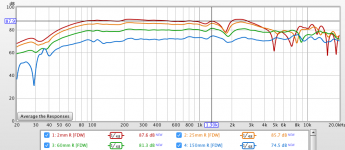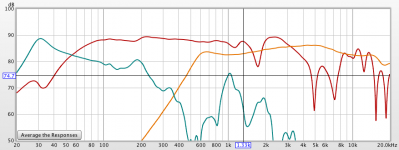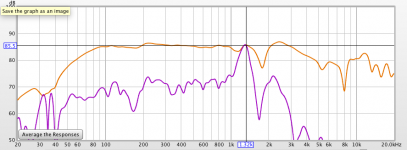AllenB, I have tried equalising the main peak, but the speakers don't sound right. Something in one of the Hypex documents said something like "be careful eq-ing diffraction peaks with Q>3 as the solution may be worse than the curse"
The Q to equalise the peak was around 4.
I'm wondering the motivation for the Hypex advice.
The Q to equalise the peak was around 4.
I'm wondering the motivation for the Hypex advice.
Diffraction wise, that's one of the worse tweeter mounting one can do.
//
I would agree - (sad face)- you have the sharp edges of the faceplate. It was placed like that because the midbass needed to be at an exact height to make the MLTM bass loading work.
The on-axis response it not bad - a 1dB dip at around 6.3kHz. The rolloff below 3kHz is due to a 30uF cap to protect the tweeter (it is an active system). I've EQed both the dip and the rolloff.
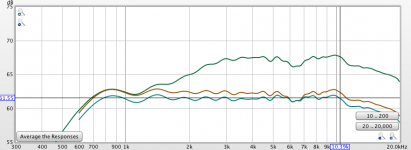
I've added in the un-eqed polar responses at 45 degrees above and below.
The dip is not present in those curves, which makes me question my own logic in EQing the on-axis dip.
I've also plotted the averaged of the three curves - not sure if this is a valid thing to do as I suspect one ought to weight the on-axis curve higher. Can this be done in REW?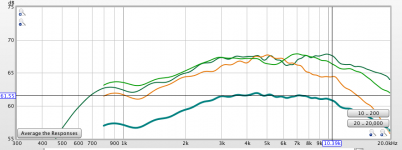
The dip is not present in those curves, which makes me question my own logic in EQing the on-axis dip.
I've also plotted the averaged of the three curves - not sure if this is a valid thing to do as I suspect one ought to weight the on-axis curve higher. Can this be done in REW?

..or lower, because the region represented by 45 degrees is much larger, assuming room power is the issue of interest.as I suspect one ought to weight the on-axis curve higher.
Either way, the variation in amplitude response on- and off-axis isn't too bad. The orange one is 45 degrees above axis and is about 3.5dB down by 10kHz. Not sure how important that is - my ceilings are 4m high.
..or lower, because the region represented by 45 degrees is much larger, assuming room power is the issue of interest.
I'm trying to remember the exact reference, but there was a paper by Harman(?), correlating loudspeaker listening test preference scores against measured responses. I believe the conclusion was to average the measured responses across the listening window (listening position +/- some height and +/- some width). I'll try to dig out the reference.
Hi Antm
The peak in your measurements is very stable, even when you move to a different measuring position. For me, that suggests as others say, this is not a diffraction problem alone. The good news is that the problem is most probably is suitable for EQ correction.
From my experience, do not to "fix" the problem completely, instead only halfway by -1.5db, use a gentle smooth Q value.
The peak in your measurements is very stable, even when you move to a different measuring position. For me, that suggests as others say, this is not a diffraction problem alone. The good news is that the problem is most probably is suitable for EQ correction.
From my experience, do not to "fix" the problem completely, instead only halfway by -1.5db, use a gentle smooth Q value.
Thanks, alfegutt, will give that a try.
By the way, I think this was the reference on listening scores... a couple of AES papers reprinted here (Harman International) :
https://www.pearl-hifi.com/06_Lit_Archive/15_Mfrs_Publications/Harman_Int%27l/AES-Other_Publications/LS_Measurements_Listener_Prefs.pdf
By the way, I think this was the reference on listening scores... a couple of AES papers reprinted here (Harman International) :
https://www.pearl-hifi.com/06_Lit_Archive/15_Mfrs_Publications/Harman_Int%27l/AES-Other_Publications/LS_Measurements_Listener_Prefs.pdf
Smart lookin build! Nice.
Yes, the tweeter arrangement isn't optimal but let's not dwell, it looks good and it's what you're working with.
So the polars of the woofer show it isn't a diffraction hump. Martin kings measurements show that it's lumpy area and anything he measured would show diffraction way below yours.
I still think normalisation and polars would help in any case. Have you got DATS or can you investigate an impedeance rig for REW?
How big is the corner radius on the cab?
I tend to organise information like this I'm not aying it's perfect but helps me keep it clear for inspection when I'm pondering and not at home (at work with audio on my mind).
Looks like it has a ot of potential to sound great.
Yes, the tweeter arrangement isn't optimal but let's not dwell, it looks good and it's what you're working with.
So the polars of the woofer show it isn't a diffraction hump. Martin kings measurements show that it's lumpy area and anything he measured would show diffraction way below yours.
I still think normalisation and polars would help in any case. Have you got DATS or can you investigate an impedeance rig for REW?
How big is the corner radius on the cab?
I tend to organise information like this I'm not aying it's perfect but helps me keep it clear for inspection when I'm pondering and not at home (at work with audio on my mind).
Looks like it has a ot of potential to sound great.
I'm assuming this is a cabinet resonance, rather than a reflection of rear-wave from the back of the cabinet.
Dug up some old measurements courtesy Martin King. It seems to me the Jordan itself is guilty of the rather rough ride around 1-3kHz.
I suggest making some burst decay plots. Measure at close range, say 2" max. See if there are resonances. If so, get the speaker out and repeat measurement in a baffle. If the resonances persist, you just have to accept them. If not, improve cabinet damping. Either way, you probably want to EQ the result.
Thanks, Mark - see below. Plot shows CSD measured at 25mm from cone centre.
Does seems to show a resonance.
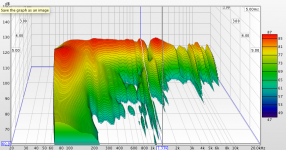
and measured directly on cabinet with tip of microphone.
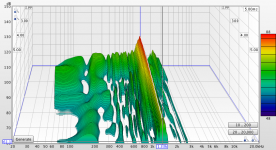
and the tweeter at 2mm - pleasingly smooth, except for 600Hz fs
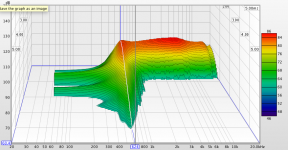
Good work! I think you found the culprit. What are the internal dimensions of the cabinet and what kind of acoustic damping did you apply?
😀
and thanks to all of you for pointing me in the right direction. Yes, the CSD is identical in both speakers.
The design is based on this one:- the pdf shows the internal dimensions:
31" MLTL design
Picture of the internals:-
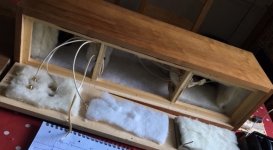
The construction is birch plywood (marine I think - I made the cabinets 9 years ago but with lockdown and everything I needed a project, so have been revisiting the crossover, making it active, DSP-based)
I more or less followed the recommendation, but added two braces that you can see in the image. These are plywood panels, each with 4 square cutouts.
The acoustic material is lambswool, double-thickness at the top and bottom. Also there some acoustic panels stuck to the top and bottom and the back panel opposite the driver (bitchumen+foam), probably these: Damping panels
I think the damping/bracing at the top and bottom is insufficient. The cabinets are inert (in terms of the knuckle test). The sides are 17mm and the baffle 25mm. However, when played loud, you can feel a light vibration on the top panel, which is probably what we are seeing in the plots. I'm thinking a vertical brace linking the centre of the top panel with the panel brace. Or a notch filter...
and thanks to all of you for pointing me in the right direction. Yes, the CSD is identical in both speakers.
The design is based on this one:- the pdf shows the internal dimensions:
31" MLTL design
Picture of the internals:-

The construction is birch plywood (marine I think - I made the cabinets 9 years ago but with lockdown and everything I needed a project, so have been revisiting the crossover, making it active, DSP-based)
I more or less followed the recommendation, but added two braces that you can see in the image. These are plywood panels, each with 4 square cutouts.
The acoustic material is lambswool, double-thickness at the top and bottom. Also there some acoustic panels stuck to the top and bottom and the back panel opposite the driver (bitchumen+foam), probably these: Damping panels
I think the damping/bracing at the top and bottom is insufficient. The cabinets are inert (in terms of the knuckle test). The sides are 17mm and the baffle 25mm. However, when played loud, you can feel a light vibration on the top panel, which is probably what we are seeing in the plots. I'm thinking a vertical brace linking the centre of the top panel with the panel brace. Or a notch filter...
- Home
- Loudspeakers
- Multi-Way
- Help with Diffraction Peak
